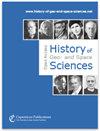在全球气候建模的黎明:利斯大气模型的奇怪案例
IF 0.4
4区 哲学
Q4 GEOSCIENCES, MULTIDISCIPLINARY
引用次数: 2
摘要
摘要20世纪50年代末至60年代初是我们模拟和预估气候变化能力发展的关键阶段,当时创建了第一个原始方程大气环流模式(AGCMs)。一个相当特殊的开发AGCM的项目实际上是由Cecil E. Leith在20世纪50年代末开始独自进行的。利斯大气模式(LAM)似乎是第一个具有水文循环的原始方程agcm,也是第一个垂直分辨率延伸到对流层顶以上的agcm。这当然是第一个具有昼夜周期的AGCM,第一个具有预测云的AGCM,也是第一个被用作计算机动画结果基础的AGCM。LAM项目大约在1965年被放弃,在期刊文献中几乎没有留下任何痕迹。值得注意的是,最近在互联网上发布的一个半个世纪前的计算机动画模拟了lam模拟的油田,这是该模型结果的第一次重要“发表”。本文根据有限的已发表的文章和报告,以及在20世纪90年代和之后对利思和其他人进行的采访记录,总结了对LAM历史的了解。本文章由计算机程序翻译,如有差异,请以英文原文为准。
At the dawn of global climate modeling: the strange case of the Leith atmosphere model
Abstract. A critical stage in the development of our ability to model and project
climate change occurred in the late 1950s–early 1960s when the first
primitive-equation atmospheric general circulation models (AGCMs) were
created. A rather idiosyncratic project to develop an AGCM was conducted
virtually alone by Cecil E. Leith starting near the end of the 1950s. The Leith
atmospheric model (LAM) appears to have been the first primitive-equation
AGCM with a hydrological cycle and the first with a vertical resolution
extending above the tropopause. It was certainly the first AGCM with a
diurnal cycle, the first with prognostic clouds, and the first to be used as
the basis for computer animations of the results. The LAM project was
abandoned in approximately 1965, and it left almost no trace in the journal literature.
Remarkably, the recent internet posting of a half-century-old computer animation
of LAM-simulated fields represents the first significant “publication” of
results from this model. This paper summarizes what is known about the
history of the LAM based on the limited published articles and reports as
well as transcripts of interviews with Leith and others conducted in the 1990s
and later.
求助全文
通过发布文献求助,成功后即可免费获取论文全文。
去求助
来源期刊

History of Geo- and Space Sciences
GEOSCIENCES, MULTIDISCIPLINARY-HISTORY & PHILOSOPHY OF SCIENCE
CiteScore
1.50
自引率
33.30%
发文量
10
审稿时长
50 weeks
期刊介绍:
The scope of History of Geo- and Space Sciences (HGSS) is to document historical facts and knowledge and to improve awareness of the history of geoscience. The knowledge of the development of geosciences and their experimental methods and theories in the past can improve our current understanding and may stimulate current research. It is encouraging for young scientists to read biographical material of historical figures in their research area. It is important as well to learn that history of science is an integrated part of the ongoing research in their research area. Another important aim of the journal is the association of historical retrospective and current research.
 求助内容:
求助内容: 应助结果提醒方式:
应助结果提醒方式:


